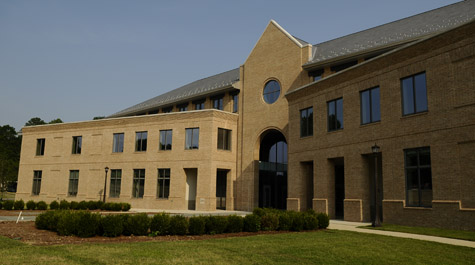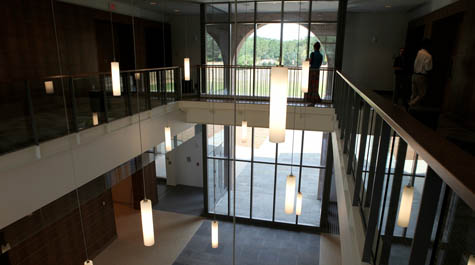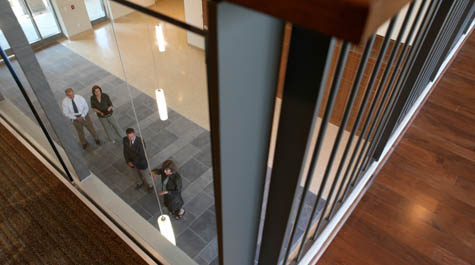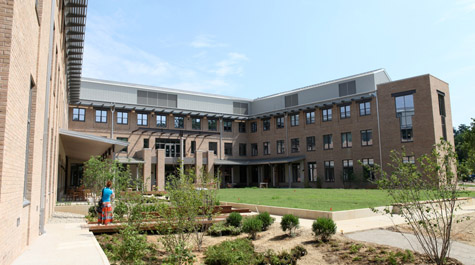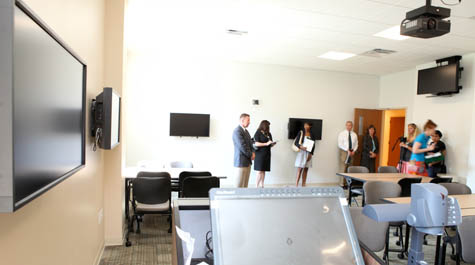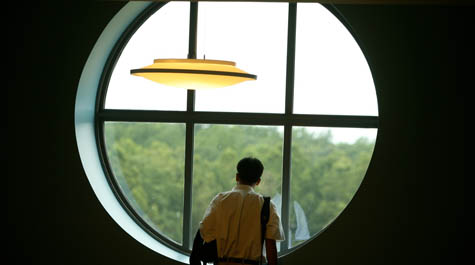School of Education ready for its close-up
Virginia McLaughlin, dean of the school, recently took local members of the press on a tour of the new building, where all of the School of Education's people and programs will be located under the same roof for the first time in 20 years. Anna Martin, vice president for administration; Tom Ward, associate dean for academic programs; and Wayne Boy, director of planning, design and construction for facilities management, also joined the tour for reporters and photographers from the Daily Press, Williamsburg-Yorktown Daily and Virginia Gazette.
In the lobby, McLaughlin noted the variety of people who would pass through the new building's doors, including babies and children, undergraduate and graduate students, the school's hundred employees, school teachers and administrators from around the world, and retirees involved in the Christopher Wren program.
"We will serve a lot of publics," she said. "This will be a hub."
The new building is approximately 113,000 square feet - quite an improvement from the 26,000 square feet in Jones Hall where the School of Education used to be housed, with many of its centers located around the campus and Williamsburg area.
The first floor of the new building features the Literacy for Life center, a tiered classroom with advanced technology options, a Java City, a board room and a professional development center that will allow the school to host its training activities for more than 20,000 educators per year in one location. The center includes two break-out rooms and a main room -Matoaka Woods - which can hold around 300 people.
Above the professional development center on the second floor of the building are classrooms that can hold 20, 30 or 40 people. Many of the classrooms feature special technology that will assist professors in teaching classes as well as helping students collaborate and share their work.
Ward said their challenge was to make the classrooms comfortable, high tech and flexible.
"And I think we hit right on that mark," he said.
The second floor of the building also includes the Learning Resources Center, Technology Integration Center and STEM Education Alliance.
The Technology Integration Center boasts its own version of Apple's "Genius Bar," where people can stop in to ask questions about using new technologies, such as streaming and smart phone applications, in their education work.
Gene Roche, director of academic information services, said that the center's aim was "to create a place where people can be comfortable exploring things they never thought of before."
Additionally located on the building's second floor is what McLaughlin refers to as the "human services wing," which includes the New Horizons Counseling Center, the Historic Triangle Substance Abuse Coalition, Project Hope and the New Leaf program, which provides counseling to William & Mary students.
"We are very much focused on outreach," said McLaughlin.
On the third floor of the building are faculty offices, work areas for graduate assistants, the special education Training and Technical Assistance Center, the Center for Gifted Education and the School Leadership Institute.
"I can't tell you how nice it is to go two doors down instead of having to drive two miles" to work with colleagues, said Lori Korinek, professor of special education.
Behind the building is a courtyard and covered portico area as well as a pathway that will allow students and faculty to walk from the main campus - near the recreation center - to the new facility.
"It's not as far as you think," said McLaughlin.
Also outside is a garden that will grow using rain water that runs off the portico. The garden was part of the plan to make the building sustainable, along with the utilization of things such as energy star equipment, natural light and motion sensors. The School of Education expects the new facility to earn a silver LEED certification.
"We recycled the whole site, literally," said Boy, noting that they reused more than 90 percent of the materials that came from the old hospital building.
The School of Education began moving to its new location, located off of Monticello Avenue at the former site of the Sentara Williamsburg Community Hospital, in mid-May beginning with the dean's offices. The rest of the School of Education began moving into the building in June. Although a few of the school's centers are currently operating out of the new facility, summer classes are being held elsewhere.
McLaughlin said that they may move a few summer classes to the new facility in July or August as a sort of "soft opening." However, the building is not expected to be completely operational until the end of August.
"We are close to completion, but not there yet," McLaughlin said.
The $48 million project was funded in part by a bond measure approved by the Virginia General Assembly in April 2008 that provided William & Mary with $38 million for construction of the new school.
A building dedication is expected to take place in September.
 Skip to main content
Skip to main content

